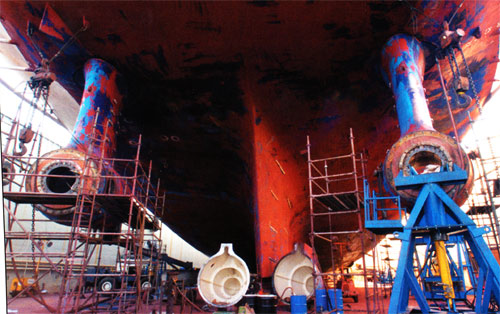 Classification societies have two roles: First, to verify that the shipowner gets the product he is paying for and that the yard is building according to rules and regulations, and second, to continuously develop new standards, moving the bar upward, being proactive, according to Karl Morten Wiklund, head of the cruise section at Det Norske Veritas (DNV).
Classification societies have two roles: First, to verify that the shipowner gets the product he is paying for and that the yard is building according to rules and regulations, and second, to continuously develop new standards, moving the bar upward, being proactive, according to Karl Morten Wiklund, head of the cruise section at Det Norske Veritas (DNV).
“Historically, DNV has had its own fire safety standards, which have been adopted by the IMO,” Wiklund explained. “The same goes for safety management systems.
“As a class society we are also in the forefront developing standards for noise, vibration and passenger comforts,” he added.
Wiklund also expects new standards to be developed for cruising in polar regions.
DNV is also part of a pod quality forum, which includes Rolls Royce, ABB and Siemens Schottel, and has contributed to raising the quality of the pods, according to Wiklund. “An electrical motor in the water is a always a challenge,” he explained. “Before being introduced on cruise ships, the pods had worked well in relatively small units. But suddenly very big pods became popular, and the manufacturers struggled to meet demand.”
DNV usually gets involved in newbuilding projects before orders are finalized.
“While the yards are very good at developing concepts, it does not help if the concepts are not in compliance (with rules and regulations),” Wiklund said.
“The World was a good example. If the ship had been contracted and built without our prior involvement, it never would have been able to sail. It is basically a residence ship with 100 kitchens.”
Ships with big atriums have also benefited from DNV’s expertise. “When new concepts are put on the table, we can help find solutions that allow new concepts to be in compliance,” Wiklund explained.
Added Olav Nakken, head of the passenger ship hull section at DNV: “We spent a lot of time solving the fire safety compliance for the Promenade aboard the Voyager class.”
Modern ships have built-in redundancies that will allow them to proceed safely to port even if they should suffer an incident.
The present rules call for all survival craft to be launched with their full complement of people within 30 minutes of the initial signal to abandon ship.
A new proposal calls for ships to either have sufficient propulsion to make it back to port or, if a ship is unable to move, or to remain “habitable” for at least three hours for evacuation.
“Conceptual thinking leads to positive development,” noted Wiklund, adding: “At DNV, we are focusing on functionality and not so much on detail requirements.
“Big cruise ships are very complex structurally,” Wiklund continued. “We do global analysis to make sure that everything functions together and to ensure safety and comfort. Most of the complexity is in the basement where all the components of the power plant and automation systems are located.
“We work to verify the functionality of the systems, including the power plant, ventilation, etc., to make sure everything is working and that everything complies with safety standards.”
All the testing information is recorded in a shared database whether the testing is done in Germany, at Hovik, or at the gas turbine manufacturer’s plant in Texas.
Said Nakken: “Our requirements of components are also important and are managed through a certification system. The products that are delivered to the yard have already been tested and certified. It means less uncertainty for the yard and the owner.
“In addition, the equipment is tested again once it is installed and again during sea trials,” Nakken added.
After delivery, there are follow-up inspections, regular annual inspections, and other special inspections.
Looking forward, Wiklund and Nakken believe that any more new technology such as fuel cells are relatively far into the future, and instead expect to see more electrical power throughout the industry and more computer automation.
Meanwhile, powerplants have already come a long way – they are very clean with minimal emissions, according to Wiklund. “Cruise ships hardly release anything into the air or water,” he said, “compared to other industries and transportation industries, they are not even close to cruise ship standards.” –Oivind Mathisen
Excerpt from the Cruise Industry News Quarterly Magazine: Winter 2004-2005



